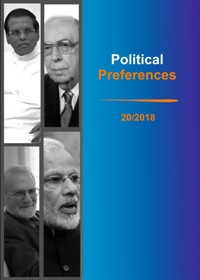Aneez, S., & Miglani, S. (2017). India eyes airport in Sri Lanka, near Chinese Belt and Road outpost. https://www.reuters.com/article/us-sri-lanka-port-india/india-eyes-airport-in-sri-lanka-near-chinese-belt-and-road-outpost-idUSKBN1CI0KI (20/06/2018).
Google Scholar
Arif, A. (2017). Sino-Nepali Military Drills 2017: Challenging Indian influence in South Asia?. Islamabad: Institute of Strategic Studies.
Google Scholar
Baral, B. (2017). After the 'Blockade': China's Push into Nepal. The Diplomat. https://thediplomat.com/2017/ 02/after-the-blockade-chinas-push-into-nepal/ (20/06/2018).
Google Scholar
Bhandari, A., & Jindal, C.(2017). Pakistan: A Reckless Mortgage. Gateway House. http://www.gatewayhouse.in/ chinese-investments-in-pakistan/ (20/06/2018).
Google Scholar
Blanchfield, K. & Wezeman, P. D., & Wezeman, S. T. (2017). The state of major arms transfers in 8 graphics. Stockholm International Peace Research Institute. https://www.sipri.org/commentary/blog/2017/state-major-arms-transfers-8-graphics (20/06/2018).
Google Scholar
Brzeziński, Z., & Scowcroft, B. (2009). Ameryka i świat. Rozmowy o globalnym przebudzeniu politycznym. Łódź: Wydawnictwo JK.
Google Scholar
Chanana, D. (2010). India's transition to Global Donor: Limitations and prospects. Real Instituto Elcano – ARI 123/2010. http://www.realinstitutoelcano.org/wps/portal/rielcano_eng/Content?WCM_GLOBAL_CONTEXT=/ elcano/elcano_in/zonas_in/asia-pacific/ari123-2010 (20/06/2018).
Google Scholar
Chandran, N. (2017). India and China compete for control of an almost empty Sri Lanka air port. https://www.cnbc.com/2017/12/13/india-and-china-rivals-compete-for-control-of-empty-sri-lanka-airport.html (20/06/2018).
Google Scholar
Chinese Ambassador calls on Nepal PM. The Himalayan Times. https://thehimalayantimes.com/kathmandu/chinese-ambassador-yu-hong-calls-on-nepal-pm-pushpa-kamal-dahal/ (20/06/2018).
Google Scholar
Furmanowicz, U. (2015). Kryzys paliwowy w Nepalu. Czas na wejście smoka?. Centrum Studiów Polska-Azja. http://www.polska-azja.pl/u-furmanowicz-kryzys-paliwowy-w-nepalu-czas-na-wejscie-smoka/ (20/06/2018).
Google Scholar
GFP (2017). 2017 Military Strength Ranking, Global Firepower. https://www.globalfirepower.com/countries-listing.asp (20/06/2018).
Google Scholar
Hasanat Shah, S. & Hasnat, H., & Rosefielde, S. (2017). Comparative Analysis of Chinese and Indian Soft Power Strategy: Analysis of Chinese and Indian Soft Power Strategy. Asian Politics & Policy, 9(2), 268–88.
Google Scholar
Hładij, A. (2016). Sri Lanka kupuje pakistańskie myśliwce JF-17. http://www.defence24.pl/sri-lanka-kupuje-pakistanskie-mysliwce-jf-17 (20/06/2018).
Google Scholar
Huggler, J. (2006). Tamil Tigers apologise for suicide bomber's murder of Rajiv Gandhi. Independent. https://www.independent.co.uk/news/world/asia/tamil-tigers-apologise-for-suicide-bombers-murder-of-rajiv-gandhi-405781.html (20/06/2018).
Google Scholar
IISS (2018). The Military Balance 2018. The International Institute for Strategic Studies.
Google Scholar
https://www.iiss.org/en/publications/military%20balance/issues/the-military-balance-2018-545f (20/06/2018).
Google Scholar
In South Asia, Chinese infrastructure brings debt and antagonizm. The Economist. https://www.economist.com/ news/asia/21738408-indian-hawks-see-unserviceable-chinese-loans-ploy-win-control-strategic-assets-south (20/06/2018).
Google Scholar
Iwanek, K. (2012). Tunel przez Himalaje – Chińsko-indyjska gra o Nepal. http://www.polska-azja.pl/k-iwanek-tunel-przez-himalaje-chinsko-indyjska-gra-o-nepal/ (20/06/2018).
Google Scholar
Kaplan, R. (2013). Monsun. Ocean Indyjski i przyszłość amerykańskiej dominacji. Wołowiec: Wydawnictwo Czarne.
Google Scholar
Kapuściński, R. (2007). Rwący nurt historii. Kraków: Wydawnictwo Znak.
Google Scholar
Krishnan, M. (2018). India 'disturbed' by Maldives' political crisis. http://www.dw.com/en/india-disturbed-by-maldives-political-crisis/a-42470247 (20/06/2018).
Google Scholar
Lim, D. J., & Mukherjee, R. (2017). Does Debt Pay? China and the Politics of Investment in Sri Lanka. The Diplomat. https://thediplomat.com/2018/01/does-debt-pay-china-and-the-politics-of-investment-in-sri-lanka/ (20/06/2018).
Google Scholar
Maldives airport to be expanded with controversial $800m China contract. The Guardian. https://www.theguardian.com/world/2016/apr/08/maldives-airport-expanded-800m-china-contract (20/06/2018).
Google Scholar
Malik, J.M. (2001). South Asia in China’s Foreign Relations. Pacifica Review, 13(1), 73–90.
Google Scholar
Malone, D. M. (2011). Does the Elephant Dance. Contemporary India Foreign Policy. New York: Oxford University Press.
Google Scholar
Mandhana, N. (2018). Trouble in Paradise: China-India Rivalry Plays Out in Maldives. The World Street Journal https://www.wsj.com/articles/trouble-in-paradise-china-india-rivalry-plays-out-in-maldives-1520332203?mod=e2fb (20/06/2018).
Google Scholar
Muni, S. D. (2017): Modi's 'Neighbourhood First' Initiative. In: S. Sinderpal (ed.), Modi And The World: (Re)Constructing Indian Foreign Policy (pp. 117–38). Singapore: World Scientific.
Google Scholar
Nepal accesses internet through China, ending India monopoly. http://business.financialpost.com/pmn/business-pmn/nepal-accesses-internet-through-china-ending-india-monopoly (20/06/2018).
Google Scholar
Oleszko-Pyka, B. (2018). Stan wyjątkowy na Malediwach czyli wielka polityka Indii, Chin oraz USA. Puls Azji. http://pulsazji.pl/2018/03/05/stan-wyjatkowy-malediwach-czyli-wielka-polityka-indii-chin-oraz-usa/ (20/06/2018).
Google Scholar
Panda, A. (2016). Revealed: Why Sri Lanka Backed Off the Sino-Pakistani JF-17 Thunder. The Diplomat. https://thediplomat.com/2016/01/revealed-why-sri-lanka-backed-off-the-sino-pakistani-jf-17-thunder/ (20/06/2018).
Google Scholar
Paudyal, M. (2017). Love, sympathy, support, indifference, silence: How Nepal is responding to the Darjeeling unrest. https://scroll.in/article/842380/love-sympathy-support-indifference-silence-how-nepal-is-responding-to-the-darjeeling-unrest (20/06/2018).
Google Scholar
Ping, J.H. (2013). China's Relations with India's Neighbours: From Threat Avoidance to Alternative Development Opportunity. Asian Journal of Political Science, 21(1), 21–40.
Google Scholar
Prasad Routray, B. (2011). India-Myanmar Relations: Triumph of Pragmatism. Jindal Journal of International Affairs, 1, 301–21.
Google Scholar
Rybczyńska, M. (2016). Nepal: „Żaden nepalski teren nie zostanie użyty do działań przeciwko sąsiadom”. Centrum Studiów Polska-Azja. http://www.polska-azja.pl/nepal-zaden-nepalski-teren-nie-zostanie-uzyty-do-dzialan-przeciwko-sasiadom/ (20/06/2018).
Google Scholar
Smolar, A. (2011). Wiek niepewności: Europa i ład światowy. Gazeta Wyborcza, 19-20.02.
Google Scholar
Sri Lanka formally hands over Hambantota port on 99-year lease to China. The Hindu. http://www.thehindu.com/ news/ international/sri-lanka-formally-hands-over-hambantota-port-on-99-year-lease-to-china/article21380382.ece (20/06/2018).
Google Scholar
Stacey, K. (2017). China signs 99-year lease on Sri Lanka’s Hambantota port. Financial Times. https://www.ft.com/content/e150ef0c-de37-11e7-a8a4-0a1e63a52f9c (20/06/2018).
Google Scholar
‘Saudi Arabia intends to secure oil routes to China through Maldives'. http://www.vnews.mv/79368 (20/06/2018).
Google Scholar
Swarajya (2018). China Looking To Set Up Ocean Observatory In Maldives, Not Far From India’s Lakshadweep Islands. https://swarajyamag.com/insta/china-looking-to-set-up-ocean-observatory-in-maldives-not-far-from-indias-lakshadweep-islands (20/06/2018).
Google Scholar
Tarabay, J. (2018). With Sri Lankan port acquisition, China adds another 'pearl' to its 'string'. CNN. https://edition.cnn.com/2018/02/03/asia/china-sri-lanka-string-of-pearls-intl/index.html (20/06/2018).
Google Scholar
Tharoor, S. (2015). Understanding Nepal’s constitutional crisis.
Google Scholar
https://www.weforum.org/agenda/2015/02/understanding-nepals-constitutional-crisis/ (20/06/2018).
Google Scholar
Veloor, R. (2010). "A man who loves his country" - complete exclusive interview with President Mahinda Rajapaksa.http://archive1.english.news.lk/category-table/14314-qa-man-who-loves-his-countryq.html (20/06/2018).
Google Scholar
Zajączkowski, J. (2009). Regionalny system bezpieczeństwa w regionie Azji Południowej. In: T. Kapuśniak, W. Lizak, & P. Olszewski (eds.) Bezpieczeństwo międzynarodowe. Wyzwania i zagrożenia XXI w. (pp. 247–64). Radom: Wyższa Szkoła Handlowa.
Google Scholar



 10.31261/polpre
10.31261/polpre